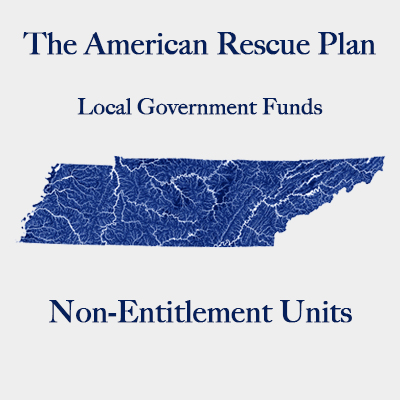Distribution Information for NEU Local Governments (11/9/2021)
Coronavirus State and Local Fiscal Recovery Funds for Non-entitlement Units of Local Government (5/24/21)
NON-ENTITLEMENT UNITS OF LOCAL GOVERNMENT (NEUs)
- Non-Entitlement Units include those municipalities with populations of less than 50,000, excluding cities that are designated principal cities of Metropolitan Statistical Areas.
How much money will Non-Entitled Units receive?
- The current total allocation estimate for Tennessee’s NEUs is approximately $438 million. The final allocations to me made to each NEU are not available at this time, but will be distributed following publication by the U.S. Treasury.
When will funds from the American Rescue Plan be received? (Updated 11/01/21)
- For Non-Entitlement Units, the U.S. Treasury will allocate and pay funds to state governments, and the state will distribute funds to non-entitlement units of local government in proportion to population based on certified numbers from the 2010 Federal Census.
- Each NEU must make request distribution of its designated federal ARPA allocation from the state of Tennessee. The state has established an online portal for such purpose. Each NEU must register with the Department of Finance and Administration (F&A), obtain login information, complete and submit the federally-required information (explained in the section below) and request distribution via F&A's online portal.
- On October 15, 2021, the state of Tennessee received a transfer from the U.S. Treasury that included $219 million, which constituted the first tranche of the federal ARPA funds.
- The state began making distributions of ARPA allocations to NEUs on October 29 and will continue distributions to all NEUs that have satisfied the requirement included in this section and requested distribution via the online portal.
- The state has 30 days from the date of application to provide the funding the the NEU.
- The second half of a city’s allocation will be distributed one year following receipt of the first half -- Payments in Tranches to Local Governments
What steps need to be taken in order to receive the funds?
- NEUs must make application for funds with the State of Tennessee. The State received a transfer of $129 million, which constitutes the first tranche of allocations to NEUs on October 15, 2021.
- The Tennessee Department of Finance and Administration has created an online portal to receive requests for distribution from NEUs. The state began making distributions to NEUs that had completed and submitted the information explained below, and submitted a request for distribution utilizing the online platform on October 29, 2021.
- Non-Entitlement Units must have a valid DUNS number to meet reporting requirements under the program.
- A DUNS number is a unique nine-character number used to identify an organization and is issued by Dun & Bradstreet. The federal government uses the DUNS number to track how federal money is allocated. Registering for a DUNS number is free of charge.
- If your municipality does not have a valid DUNS number, please visit this page or call 1-866-705-5711 to begin the registration process.
- In addition to a DUNS number, it is also recommended that NEUs gather the following information in preparation for the State's opening of the application process:
- Local government name
- Local government’s Taxpayer Identification Number
- Mailing address
- Authorized representative name, title, phone and email
- Financial institution information (e.g., routing and account number, financial institution name and contact information)
- Total NEU budget (defined as the annual total operating budget, including general fund and other funds, in effect as of January 27, 2020)
- Signed award terms and conditions agreement (as provided by Treasury to be signed)
- Assurances of compliance with Title VI of the Civil Rights Act of 1964 (as provided by Treasury to be signed).
Are there any restrictions on uses of the funds?
- Uses of federal funds that are expressly prohibited (additional details provided in the links at the bottom of this page):
- Directly or indirectly offsetting a tax cut (Guidance seems to clarify this prohibition applies only to States and territories)
- Pension funds
- As non-Federal match where prohibited by other Federal programs
- To directly service debt
- Satisfy a judgment or settlement
- Contribute to "Rainy Day" fund
- Costs for audits not performed in accordance with 2 CFR Part 200, Subpart F
- From Interim Final Rule: Restrictions on Use
How long is the time frame to spend the funds?
- Funds for local governments will need to be obligated by December 31, 2024 and expended by December 31, 2026.
- From Interim Final Rule: Timeline for Use of Funds
What are the rules regarding reporting?
From Interim Final Rule: Reporting
Quarterly Project and Expenditure reports: State (defined to include the District of Columbia), territorial, metropolitan city, county, and Tribal governments will be required to submit quarterly project and expenditure reports. This report will include financial data, information on contracts and subawards over $50,000, types of projects funded, and other information regarding a recipient’s utilization of award funds. Reports will be required quarterly with the exception of nonentitlement units, which will report annually. An interim report is due on August 31, 2021. The reports will include the same general data as those submitted by recipients of the Coronavirus Relief Fund, with some modifications to expenditure categories and the addition of data elements related to specific eligible uses. The initial quarterly Project and Expenditure report will cover two calendar quarters from the date of award to September 30, 2021 and must be submitted to Treasury by October 31, 2021. The subsequent quarterly reports will cover one calendar quarter and must be submitted to Treasury within 30 days after the end of each calendar quarter. Nonentitlement units of local government will be required to submit the project and expenditure report annually. The initial annual Project and Expenditure report for nonentitlement units of local government will cover activity from the date of award to September 30, 2021 and must be submitted to Treasury by October 31, 2021. The subsequent annual reports must be submitted to Treasury by October 31 each year.
Treasury will provide further guidance and instructions on the reporting requirements for program at a later date.

How may the funds be utilized?
Eligible Uses:
A. Public Health and Economic Impacts Overview
- Responding to COVID-19 -- Support public health expenditures, by funding COVID-19 mitigation efforts, medical expenses, behavioral healthcare, and certain public health and safety staff
- Responding to Negative Economic Impacts -- Address negative economic impacts caused by the public health emergency, including economic harms to workers, households, small businesses, impacted industries, and the public sector
- Uses Outside the Scope of this Category
B. Premium Pay for Eligible Workers -- Provide premium pay for essential workers, offering additional support to those who have borne and will bear the greatest health risks because of their service in critical infrastructuresectors
C. Lost Public Sector Revenue -- Replace lost public sector revenue, using this funding to provide government services to the extent of the reduction in revenue experienced due to the pandemic
D. Infrastructure (Overview) -- Invest in water, sewer, and broadband infrastructure, making necessary investments to improve access to clean drinking water, support vital wastewater and stormwater infrastructure, and to expand access to broadband internet
Additional Info from Interim Final Rule:




